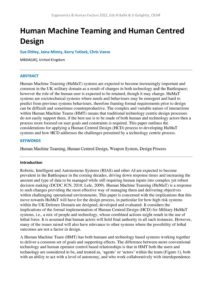| Document | Author Sue Ottley, Jaina Mistry, Kerry Tatlock & Chris Vance |
| Abstract Human Machine Teaming (HuMaT) systems are expected to become increasingly important and common in the UK military domain as a result of changes in both technology and the Battlespace; however the role of the human user is expected to be retained, though it may change. HuMaT systems are sociotechnical systems where needs and behaviours may be emergent and hard to predict from previous systems behaviours, therefore framing formal requirements prior to design can be difficult and sometimes counterproductive. The complex and variable nature of interactions within Human Machine Teams (HMT) means that traditional technology centric design processes do not easily support them, if the best use is to be made of both human and technology actors then a process more focused on user goals and constraints is required. This paper outlines the considerations for applying a Human Centred Design (HCD) process to developing HuMaT systems and how HCD addresses the challenges presented by a technology centric process. |

